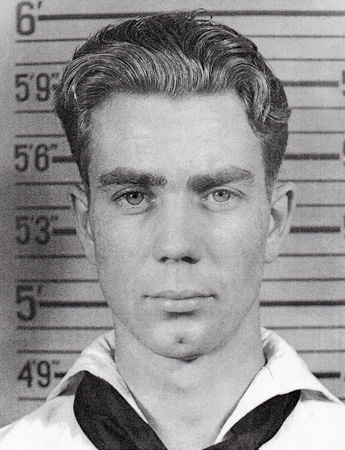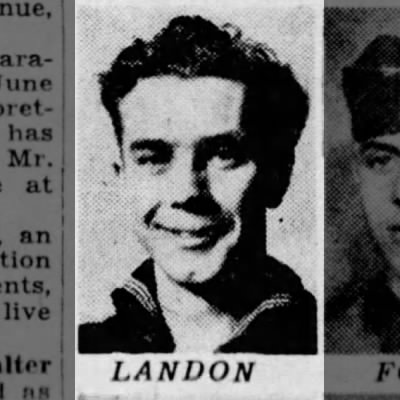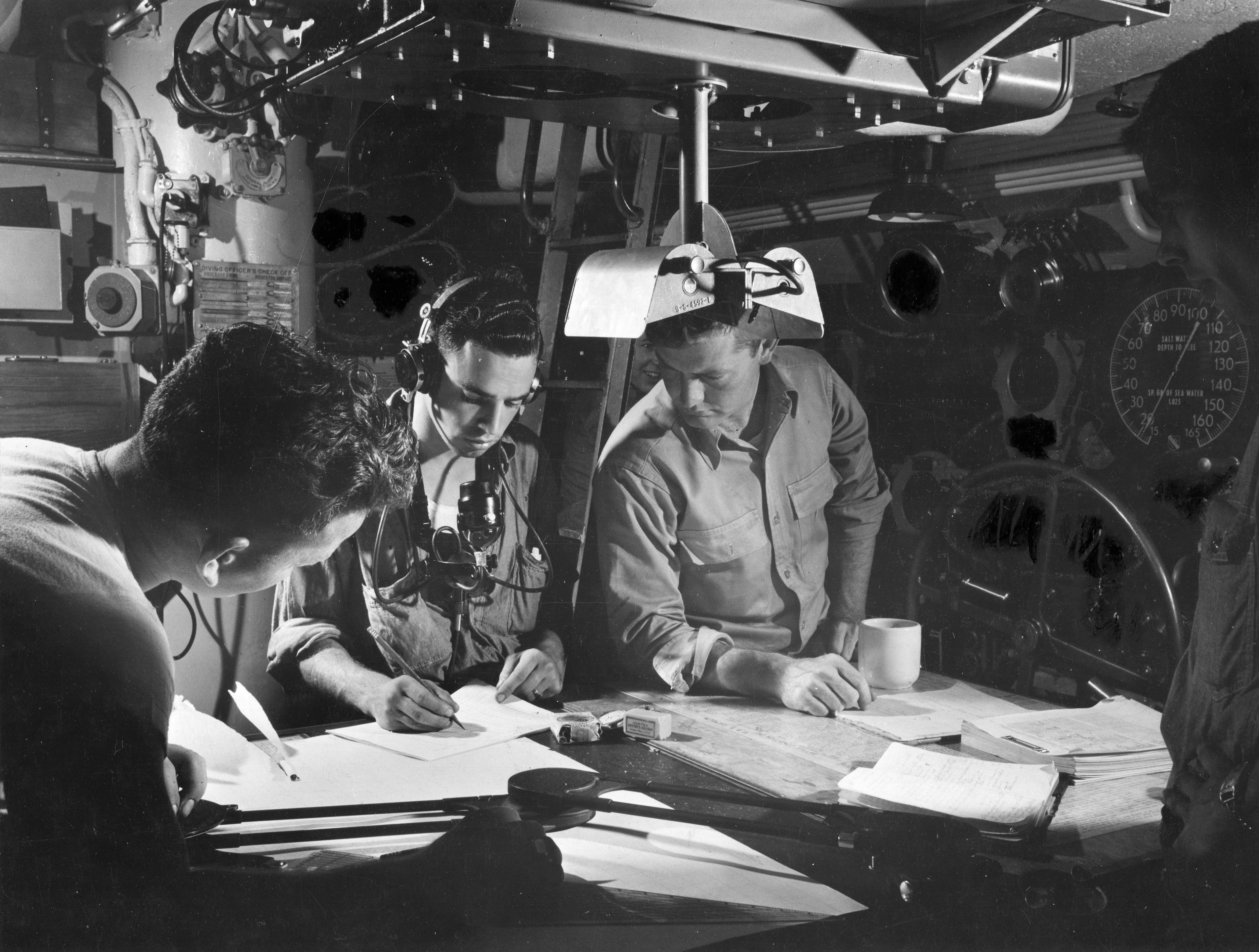Motor Machinist’s Mate First Class Clayton Lloyd Landon

- Unit: USS Tullibee
- Service Number: 3371131
- Date of Birth: July 18, 1921
- Entered the Military: January 4, 1939
- Date of Death: December 15, 1945
- Hometown: St. Louis, Missouri
- Place of Death: Pacific Ocean
- Award(s): Purple Heart
- Cemetery: Walls of the Missing. Manila American Cemetery and San Francisco National Cemetery
Lorena High School
2016-2017
Early Life
Clayton Lloyd Landon grew up in St. Louis, Missouri, as the eldest child of a middle-class family. Landon had two younger siblings, a brother, Jean, and sister, Marian. His father, Newton, who advertised as a Rickenbacker Factory expert, was an auto mechanic and shop superintendent who eventually owned a shop in St. Louis. Landon’s mother, Grace, stayed at home to care for the children.
In 1933 when Clayton was 11, his parents divorced. The years that followed seemed difficult for the single mother and children. In 1936, Jean (age 12) lived in the Christian Orphaus House, and Marian (age 9) arrived soon thereafter. The family was completely split up by the time of the 1940 census. Grace lived in a boarding house and worked as a bookkeeper. Jean (16) lived with his paternal grandfather. Marian (13) lived in the orphanage, and Clayton (17) enlisted in the U.S. Navy in 1939. Clayton’s father remarried and worked as a foreman in a pencil factory.
Before Clayton signed up for the U.S. Navy in 1939, he was enrolled as a student in the machine shop program at Ranken Trade School from September 1937 to May 1938. The last grade he completed was ninth grade. In his application for enlistment, Clayton declared that his reason for enlisting was so that he could learn a trade.
This ruddy, brown-haired, blue-eyed boy entered the service at age 17. He applied for an appointment at the U.S. Naval Academy in Annapolis, but instead was enrolled in the U.S. Navy Training School (USNTS) in Great Lakes, Illinois.

Military Experience
Landon reported to the USNTS in early January 1939, and within a month he was an apprentice seaman. He continued to work hard and was promoted through the ranks: from Crew Messman to Fireman Third Class, Fireman Second Class, and eventually Fireman First Class and then into the Petty Officer ranks as a Machinist Mate. Sailors serving the Machinist Mate rating worked with ship engines. During this time, he served on various ships including the USS Honolulu, the USS Phoenix, the USS Viero, and the USS Boise.
Landon extended his enlistment on July 3, 1942, and entered submarine school in New London, Connecticut. In the fall of 1942, Landon traveled to Naval Station Key West to serve in Submarine Division 12, where he underwent 12 weeks of instruction. He qualified in submarine torpedo boat duty and was recommended for advancement at the end of the training.
In early 1943, Landon was part of the crew on the USS Tullibee and briefly served as staff aboard the USS Drum. His first war patrol was on the Tullibee, which started from Honolulu on July 19, 1943, and ended at Midway Island. Landon’s next assignment was spent serving four months on the staff of a rear admiral.
The Bluejacket’s Manual (the basic handbook for U.S. Navy personnel) described the job of a motor machinist mate as operating machine tools to maintain the internal combustion engines and engine auxiliaries, as well as pressure and air systems. On December 2, 1943, Landon was transferred back to the Tullibee where he again served on the submarine’s third and fourth patrols in enemy waters. Landon continued to move up in rank from Motor Machinist Mate Second Class to Motor Machinist Mate First Class and served a vital role on submarines.
Patrolling the Pacific
Submarines were a vital part of the war in the Pacific. Japan depended on shipping to continue its war effort. To win the war, the U.S. understood it had to stop Japanese shipping. In his book, Execute Against Japan, Joel Holwitt commented that the fleet submarine was an “integral part of the battleship fleet…perfectly suited to serve as scouts, advancing deep into enemy waters to report enemy ship movements.”
Although submarines made up only two percent of the U.S. Navy, these dedicated warriors destroyed much of the Japanese fleet during World War II, according to author Gordon Jackson. A patrol could last up to two months. Following the policy of unrestricted warfare, U.S. submarines hunted down the enemy and targeted all Japanese vessels because of their potential threat and economic value to Japan.
The submariner, one of the most dangerous jobs in the Navy, received hazard pay and understood the risk each time he descended into the ocean. The “silent service” was dangerous; submariners suffered an alarming 40 percent casualty rate, and yet at the same time, they destroyed 53 percent of all Japanese ships sunk by U.S. naval forces.
Dangers came from not only the enemy but also from the newness of the submarine technology and the unreliability of the torpedoes (missing targets, failed detonation, circular runs). For almost 18 months, the United States engaged the enemy with only 30 percent of weapons, mainly torpedos, working properly.
The Tullibee’s final patrol departed Honolulu on March 5, 1944. She arrived at her station off Palau and on March 25 headed out on patrol. The statement by the only survivor, Clifford Weldon Kuykendall, retold her final hours. In his official report to the U.S. Navy, Kuykendall stated that on March 27 the Tullibee was actively tracking a Japanese convoy northeast of Palau Island. The weather was stormy, and there was “low visibility…weather squally, the seas choppy and the night very dark.” Kuykendall was standing on the deck of the Tullibee, which was on the surface of the water.
Kuykendall described how the Tullibee launched two torpedoes, and about sixty seconds after launch, felt a “tremendous concussion” and was blown off deck. In the water, he inflated his life belt and watched as the bow of the submarine rose up at a 45 degree angle. For almost ten minutes, he heard American voices “calling back and forth,” but he could not “identify who or how many were calling.” He was in a heavy oil slick and an estimated seventy-five yards from the submarine.
The bow disappeared behind a heavy black cloud. At daybreak, he “found himself still in the oil slick. He could see no debris nor any other survivors in the water…[and] at about 10:00, Kuykendall saw a destroyer approaching…he received five flesh wounds from machine gun fire” and was picked up by the Japanese and transported to Japan as a POW. All other men, including Landon, were presumed dead. Kuykendall believed “that one of the submarines own torpedoes caused the explosion.”



Eulogy
Landon’s mother and sister were notified by telegram that he was missing on May 19, 1944, and an official letter from the U.S. Navy was sent on August 6, 1944, from the 142nd Submarine Division. In the beginning, they received little information, but it slowly became available. Landon’s mother, who joined the Women’s Army Corps soon after the war began, was stationed in Utica, New York, as a sergeant, working at the Rhoads General Hospital.
A letter to Landon’s mother from Vice Admiral Charles Lockwood read, “As Motor Machinist’s Mate First Class of the U.S.S. TULLIBEE, Clayton Lloyd Landon’s performance of duty materially contributed to the success of this vessel against the enemy… his splendid performance of duty, which is in keeping with the highest traditions of the Naval Service.”
Within the same month of receiving this letter in 1945, Grace received a collection of three photographs from a Navy chaplain, Lieutenant Doggett. In the letter, he described pictures of Landon prior to his detachment from the submarine base in Pearl Harbor.
Families of service members who are Missing in Action or Lost at Sea have the right to petition the government and ask for a memorial marker to be placed in a national cemetery. Grace Landon moved to California after the war, and she chose to have her son memorialized in the San Francisco National Cemetery. His headstone was erected on December 20, 1962, with the inscription: “In Memory of Clayton Lloyd Landon.” Landon is also one of the more than 36,000 men and women whose names appear on the Walls of the Missing in the Manila American Cemetery.


Reflection
Bibliography
Bluejacket’s Manual. Annapolis: U.S. Naval Institute, 1944.
“Clayton L. Landon” American Battle Monuments Commission. Accessed February 1, 2017. www.abmc.gov/node/467997#.WO045IgrLIU.
Clayton Lloyd Landon, Official Military Personnel File, Department of the Navy, Records of the Bureau of Naval Personnel, RG 24, National Archives and Records Administration – St. Louis.
The control room of the USS Capelin (SS-289) at Submarine Base New London, Connecticut. Photograph. November 4, 1943. National Archives and Records Administration (468521). Image.
Holwitt, Joel Ira. Execute Against Japan. College Station: Williams-Ford Texas A&M University Military History Series, 2009.
Hood, Jean ed. Submarine: An Anthology of First Hand Accounts of the War under the Sea. New York: Bloomsbury Publishing, 2012.
Jackson, Gordon. “WWII Submarine Veterans Pay Heavy Toll.” The Brunswick News, November 5, 2015. www.military.com/daily-news/2015/11/05/wwii-sub-vets-pay-heavy-toll.html.
Missouri. St. Louis County. 1930 U.S. Census. Digital Images. ancestry.com.
Missouri. St. Louis County. 1940 U.S. Census. Digital Images. ancestry.com.
Verdino. “Orphans get a treat.” St. Louis Star and Times, February 20, 1936, www.newspapers.com/image/?spot=8060867.
Ships, Stations, Units and Incidents Casualty Information Records. 1941-45; Records of the Bureau of Naval Personnel, Casualty Assistance Branch, Record Group 24 (Box 93); National Archives at College Park, College Park, MD.
Shireman, Douglas A. “U.S. Torpedo Troubles During WWII”. WWII Magazine, Feb. 1998. History Net www.historynet.com/us-torpedo-troubles-during-world-war-ii.htm
The USS Tullibee (SS-284) off the Mare Island Navy Yard, California. Photograph. April 2, 1943. Naval History and Heritage Command (NH 98409). Image. www.history.navy.mil/our-collections/photography/numerical-list-of-images/nhhc-series/nh-series/NH-98000/NH-98409.html.
This profile was researched and created with the Understanding Sacrifice program, sponsored by the American Battle Monuments Commission.

